On our half-hour or so walk to the train station in Bruges, Steven and I passed some sweet window boxes and decorations that made the stroll that much more enjoyable.
Attractive murals dotted the walls of the Ghent train station that was only a short hour hop from Bruges.
The center of historic Ghent was Korenmarkt Square which was enclosed by historic townhouses with classical gables which hearkened back to the city's glory days in the Middle Ages when the wool trade made it wealthy. In a period when most of Europe was rural farmland, Ghent's population was 65,000, which made Paris the only bigger city north of the Alps. Ghent was so large that, unlike other Belgian cities, it didn't have only one Grote Markt or Great Market - it had several, each focusing on different trades.
Surely one of the biggest post offices we've ever seen was this mix of Neo-Gothic and Neo-Renaissance styles that was completed in 1910 when Ghent experienced another period of wealth. Over its entrance were symbols glorifying different areas of Belgium and the Belgian Congo. The post office was now home to fancy shops.
The busts were of the leaders who had joined the International Postal Union quite an accomplishment in an era when the world's economy was cobbled together by letters and documents sent through the mail.
Florence Nightingale's fame as a nurse during the Victorian era even reached Ghent as her image graced the statue on the side of the building.
From St. Michael's Bridge, we had great views of the elaborate guild houses that lined the embankment of the Lys River. At the far end of the canal was the Castle of the Counts where we would end our walking tour of Ghent.
When the Church of St. Nicholas was built in the 13th-century in honor of St. Nicholas the patron saint of sailors, it was a boom time for Ghent. According to travel writer Rick Steves, the church became a favorite of river traders who sold their goods on the Korenmarkt.
As the Ghent region was at the vanguard of the 16th-century's Protestant Reformation, Catholic churches were stripped of all adornments including the medieval stained-glass windows by Calvinist Protestants to differentiate them from Catholic 'idolatry' and wealth. The Baroque altar had corkscrew columns that were painted wood instead of marble.
Across from the church was the 15th-century Masons' Guild House whose facade was only revealed in 1976 behind a brick wall during renovations. The six twirling dancers atop the building were added then!
I wasn’t quite sure what to think of the nearby ultramodern City Market Hall that was juxtaposed with the elegant, gabled guild houses, post office, and even the simpler Protestant Church. The hall sure had to be more attractive than the ugly parking garage it replaced but as locals have dubbed it the Sheep Shed, you wonder how much better it was! We did make use of the free WCs on the bottom level a couple of times so I couldn’t complain too much about its appearance.
Since the 14th-century, the Belfry has housed the parchment record of Ghent’s favored privileges that were granted to the city by Flanders counts in exchange for financial aid. The spire, however, was added in 1913 when the city hosted the World’s Fair.
The belfry was also a fire tower as symbolized by the four guards posted at the corners.
The dragon symbolized a protector who watches over the city’s rights all day and night and not a devil as would have been typical in the Middle Ages.
At the bottom and behind the tower was the immense Cloth Hall which was of great importance to the city known for its textiles.
The square beyond the belfry was Sint-Baafsplein or St. Bavo's Square that was a symbolic battleground in the 1800s and 1800s between Belgium's French and Dutch-speaking people even though the Dutch were more populous.
In the middle of the square was a statue of a handsome couple that honored the resurrection of the Dutch language in the city. On their flag was a lion, the symbol of Flanders.
The relief on the base depicted one of the founders of the Flemish revival movement, Jan Frans Willems. Ghent’s distinguished university didn’t even offer courses taught in Dutch for one hundred years to give you a sense of how powerful the French speakers were in Flanders.
Dominating the square was the fancy Dutch Theater that finally gave the Dutch-speaking citizens of Ghent in 1899 a location to perform plays in their own language.
The mosaic showed Apollo returning to Parnassus as the Flemish no doubt did coming home to their own language.
We had hoped to visit St. Bavo's Cathedral then on the square as that had been our central reason for coming to Ghent but it was closed for a few hours. Walking down a street next to the cathedral we passed the former home of the powerful Achtersikkel family which had been restored as a music academy.
while the black-and-gold columned Neoclassical section on another side was added a century later.
A few steps beyond the end of City Hall was a narrow passageway known as Graffitistraat which had been designated as the street Ghent citizens could apply their artistic skills.
Halfway down Graffiti Street was a pretty little park where some people had gathered on that Sunday morning to bake bread in the open oven.
We came to a fun street full of boutiques that were perfect for window-shopping.
Yet another large square in Ghent was Vridjagmarkt or Friday Market Square but market 'day' is now several days a week.
Jakob van Artevelde, a smart 14th-century ordinary businessman, "saved the day" when Ghent was divided between the French who controlled the city and the English who provided the wool for the cloth industry. Though not an aristocrat, Van Artevelde negotiated directly with the king to have Ghent remain neutral. During the nationalist period of the late 19th and early 20th-centuries when the city's Flemish people advocated for independence from the French-speakers, his memory was resurrected.
It was fun to gawk at some especially striking gables on a nearby street.
An unusual antique store in the street had a table among the bric-a-brac where four patrons were enjoying coffee, something I don't recall seeing before.
How would you like that as a coat hanger?!
Back on the square, signs atop the building read Ons Huis or House of the People and Bond Moyson advocating socialist health insurance as it was the regional headquarters for the socialist party. With such a long industrial heritage, it wasn't surprising to learn that Ghent was the birthplace of the original Belgian Labor Party. Do you think the crow above the door was trying to wake up the workers?!
The Patershol district was, until recently, run-down and dangerous but has since become one of the trendiest in Ghent with interesting restaurants and shops.
Fortunately, Steven was able to pick out panels with figures on the district's red brick building that symbolized some of the five senses.
The monkey, for instance, represented taste,
the dog, smell ...
the deer, hearing ...
and the eagle, sight. I missed the last one, humans representing touch. Sorry, but these give you a good idea of how remarkable these panels were.
The adjacent building wasn't to be outdone as it featured on its facade six panels demonstrating virtues. As the seventh, burying the dead, was judged to be too brutal to depict, it was symbolized by the urn on top. I wasn't sure that was any better, mind you!
As much as we both loved the quieter and peaceful Bruges, Ghent was also immensely charming with tiny bridges over scenic canals. It was a lot more frenetic with gobs more people and tour boats.
We'd finally reached, but didn't tour, the Castle of the Counts that we'd first caught a glimpse of when we started on our walk a few hours earlier. The rough-stone fortress had been constructed in 1180 by Philip of Alsace, not to protect the citizens but instead to dominate Ghent's independent-minded citizens. The castle was modeled on one Philip had seen in Syria when he was present for the Second Crusades.
On the same Sint-Veerelplein square as the castle was the Old Fish Market. On the top was Neptune with statues representing Ghent's two rivers, the Scheldt and Lys, below him.
As you'll soon see, Steven and I were so glad we crossed another tiny bridge to view the medieval Butchers Hall in Groentenmarkt Square. Until the 19th-century, this was the only stop in the city that people could purchase meat because of hygiene concerns.
As it was quite a lovely weekend day, people were enjoying drinks and desserts at the small tables lined up on the narrow bridge
The other side of the closed Butchers' Hall had shacks outside where offal and sausage used to be sold. Now, more popular snacks were sold.
When Steven and I saw a couple and their young child sitting at one of the tables on the bridge each devouring one of these heavenly treats, we treated ourselves and shared one. The ice cream was mouthwatering and the fresh Belgian strawberries tasted like they had been picked that morning!
It was hard to guess that there had been a raging pandemic not long ago with so many countries closed down as Ghent's streets, shops, restaurants, and cafes were packed.
Ghent was the last city we visited in Belgium and the number of trams there was mind-boggling. We had to be so careful crossing streets as they came from every direction and barely slowed down for slowpokes like us who occasionally dilly daddled!
Where would anyone find their bike in the bike lot outside the train station?!
Though Bruges remained my favorite city of those we visited in Belgium over almost two weeks, Ghent came in pretty close. It had the same exquisite canals, attractively gabled buildings, beautiful squares, interesting shopping but it was so much more intense that it made us relieved we'd picked Bruges to be our headquarters in Flanders. Ghent felt like Bruges on steroids to me and we didn't 'need' that on vacation!
Next post: Our initial reason for coming to Ghent - the sublime Ghent Altarpiece in the city where modern oil painting was born.
Posted on November 12th, 2021, on our last day in Varenna on Lake Como before we head to Milan in the morning.
















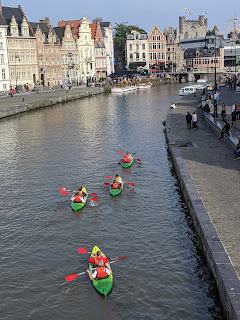


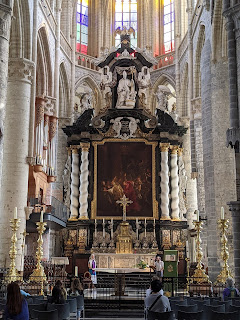









































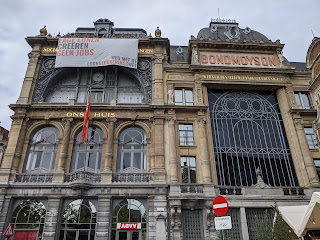








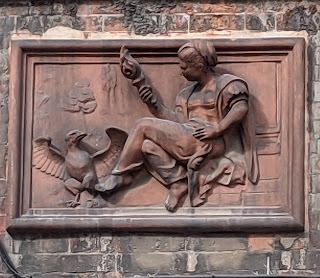

















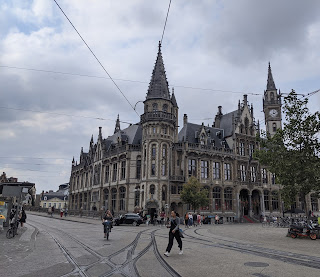

No comments:
Post a Comment